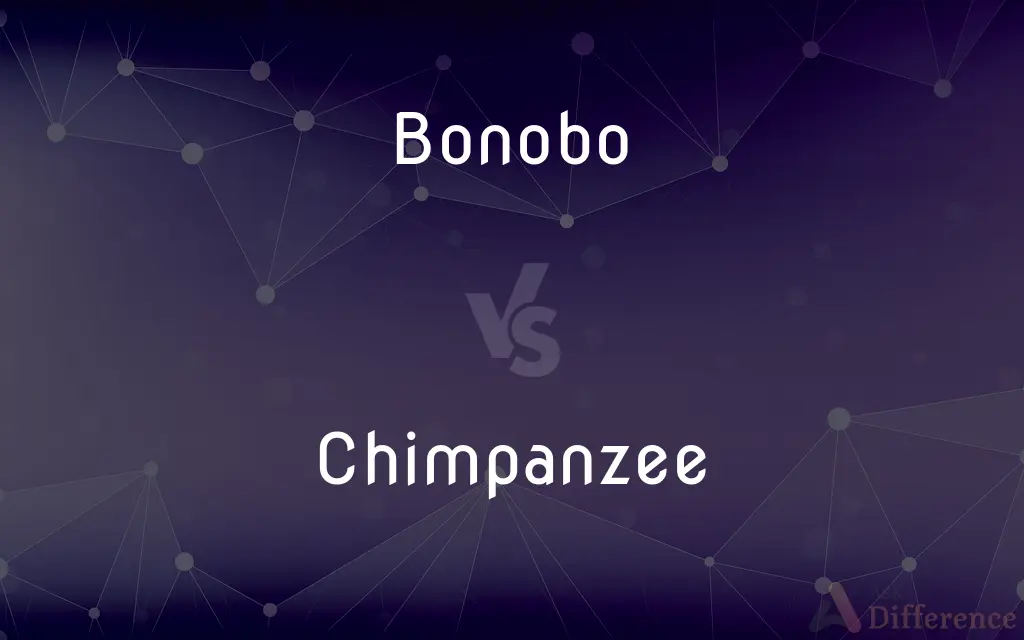Bonobo vs. Chimpanzee — What's the Difference?
Edited by Tayyaba Rehman — By Fiza Rafique — Updated on September 20, 2023
Bonobos are a species of great ape closely related to chimpanzees, known for their peaceful nature; chimpanzees are more widespread and exhibit aggressive behaviors.

Difference Between Bonobo and Chimpanzee
Table of Contents
ADVERTISEMENT
Key Differences
Bonobos and chimpanzees, though similar in many respects, are distinct species of great apes. Bonobos, scientifically named Pan paniscus, are sometimes referred to as "pygmy chimpanzees" due to their slightly smaller size. In contrast, the common chimpanzee is known as Pan troglodytes.
While both bonobos and chimpanzees are native to the forests of central Africa, their habitats do not overlap. Bonobos inhabit areas south of the Congo River, while chimpanzees can be found to the north. This river serves as a natural barrier preventing the two species from intermingling.
One prominent distinction between bonobos and chimpanzees lies in their social structures and behaviors. Bonobos are celebrated for their matriarchal societies and relatively peaceful nature, often resolving conflicts through sexual behaviors. Chimpanzees, however, have been observed to exhibit more aggressive behaviors, with males dominating their social groups.
Physically, subtle differences exist between bonobos and chimpanzees. Bonobos tend to have a more slender build, with longer legs and a face that appears more juvenile. Chimpanzees possess a more robust physique and often exhibit facial and body features that are more pronounced.
Both bonobos and chimpanzees share over 98% of their DNA with humans, making them our closest living relatives. However, the two species diverged from each other approximately one to two million years ago, each adapting uniquely to its environment and social constructs.
ADVERTISEMENT
Comparison Chart
Scientific Name
Pan paniscus
Pan troglodytes
Habitat
South of the Congo River
North of the Congo River
Social Structure
Matriarchal, peaceful
Male-dominated, can be aggressive
Physical Appearance
Slender build, longer legs, youthful face
Robust build, pronounced facial and body features
Relation to Humans
Shares over 98% of DNA, one of the closest relatives
Shares over 98% of DNA, one of the closest relatives
Compare with Definitions
Bonobo
Often referred to as the "pygmy chimpanzee."
Although smaller, the bonobo is just as intelligent as its larger cousin.
Chimpanzee
Capable of using tools and exhibiting problem-solving skills.
Researchers observed the chimpanzee using a stick to fish for ants.
Bonobo
Recognized for its matriarchal societies.
In bonobo groups, females often hold significant influence.
Chimpanzee
Known to exhibit aggressive behaviors and territorial disputes.
The male chimpanzee displayed dominance by charging at an intruder.
Bonobo
A species of great ape known for its peaceful nature.
The bonobo resolved its conflicts without resorting to violence.
Chimpanzee
Recognized for its intelligence and complex social structures.
Chimpanzees, in their natural habitat, form tight-knit communities.
Bonobo
Inhabits regions south of the Congo River in central Africa.
Bonobos can be found living in the dense rainforests of the Congo Basin.
Chimpanzee
A species of great ape native to central Africa.
The chimpanzee skillfully used tools to extract termites from a mound.
Bonobo
Known to communicate using complex vocalizations and gestures.
The bonobo's vocalizations conveyed a range of emotions and intentions.
Chimpanzee
Has a robust build with pronounced facial features.
The chimpanzee's strong arms allowed it to swing effortlessly between trees.
Bonobo
The bonobo (; Pan paniscus), also historically called the pygmy chimpanzee and less often, the dwarf or gracile chimpanzee, is an endangered great ape and one of the two species making up the genus Pan; the other being the common chimpanzee (Pan troglodytes). Although bonobos are not a subspecies of chimpanzee (Pan troglodytes), but rather a distinct species in their own right, both species are sometimes referred to collectively using the generalized term chimpanzees, or chimps.
Chimpanzee
The chimpanzee (Pan troglodytes), also known as the common chimpanzee, or simply chimp, is a species of great ape native to the forest and savannah of tropical Africa. It has four confirmed subspecies and a fifth proposed subspecies.
Bonobo
A species of chimpanzee (Pan paniscus) found only in the Congo River basin of the Democratic Republic of the Congo, having black hair and a more slender build than the common chimpanzee (P. troglodytes). Also called pygmy chimpanzee.
Chimpanzee
Either of two African apes of the genus Pan, having black hair, a bare face, somewhat arboreal habits, and a high degree of intelligence.
Bonobo
The pygmy chimpanzee, Pan paniscus, from Africa south of the Congo river.
Chimpanzee
The common chimpanzee (Pan troglodytes), of equatorial central and western Africa, having a stockier build than the bonobo (P. paniscus).
Bonobo
An anthropoid ape (Pan paniscus), resembling but smaller than the common chimpanzee (Pan troglodytes); - called also pygmy chimpanzee. It is found in the forests of Zaire.
Chimpanzee
Pan troglodytes, a species of great ape in the genus Pan, native to Africa, and believed by biologists to be the closest extant relative to humans along with the bonobo.
Bonobo
Small chimpanzee of swamp forests in Zaire; a threatened species
Chimpanzee
(broadly) A member of the genus Pan, including the bonobo which is also known as the pygmy chimpanzee.
Chimpanzee
An african ape (Pan troglodytes, formerly Anthropithecus troglodytes, or Troglodytes niger) which approaches more nearly to man, in most respects, than any other ape. It is the most intelligent of non-human animals, and when full grown, it is from three to four feet high. A variant called the pygmy chimpanzee, or bonobo, has been recently recognized as a separate species.
Chimpanzee
Intelligent somewhat arboreal ape of equatorial African forests
Common Curiosities
Where can bonobos be found in the wild?
Bonobos inhabit regions south of the Congo River in central Africa.
Do bonobos use tools like chimpanzees?
Both bonobos and chimpanzees have been observed using tools, though chimpanzees are more renowned for this behavior.
Are chimpanzees aggressive by nature?
Chimpanzees can exhibit aggressive behaviors, especially during territorial disputes.
Which species is larger, bonobos or chimpanzees?
Chimpanzees are generally larger and more robust than bonobos.
Are bonobos and chimpanzees the same species?
No, bonobos and chimpanzees are distinct species of great apes.
Which species is closer to humans in terms of DNA?
Both bonobos and chimpanzees share over 98% of their DNA with humans.
How long do bonobos live?
In the wild, bonobos can live up to 40 years, and longer in captivity.
Are bonobos endangered?
Yes, bonobos are classified as endangered due to habitat loss and poaching.
How large are chimpanzee communities?
Chimpanzee communities can vary in size, but they typically consist of 20 to 150 individuals.
Do bonobos build nests like chimpanzees?
Yes, both bonobos and chimpanzees build sleeping nests in trees using leaves and branches.
Why are bonobos sometimes called "pygmy chimpanzees"?
The term "pygmy chimpanzee" refers to the bonobo's slightly smaller size compared to the common chimpanzee.
Is it true that bonobos resolve conflicts through sexual behaviors?
Yes, bonobos often use sexual behaviors as a means of reducing tension and resolving disputes.
Do chimpanzees have a language?
While not a "language" in the human sense, chimpanzees communicate using a complex system of vocalizations, gestures, and facial expressions.
Are chimpanzees found outside Africa?
Wild chimpanzees are native to central Africa, but they can be found in zoos and research facilities worldwide.
What do chimpanzees eat?
Chimpanzees are omnivorous, consuming fruits, leaves, insects, and occasionally meat.
Share Your Discovery

Previous Comparison
Maxim vs. Axiom
Next Comparison
Sorbet vs. SherbetAuthor Spotlight
Written by
Fiza RafiqueFiza Rafique is a skilled content writer at AskDifference.com, where she meticulously refines and enhances written pieces. Drawing from her vast editorial expertise, Fiza ensures clarity, accuracy, and precision in every article. Passionate about language, she continually seeks to elevate the quality of content for readers worldwide.
Edited by
Tayyaba RehmanTayyaba Rehman is a distinguished writer, currently serving as a primary contributor to askdifference.com. As a researcher in semantics and etymology, Tayyaba's passion for the complexity of languages and their distinctions has found a perfect home on the platform. Tayyaba delves into the intricacies of language, distinguishing between commonly confused words and phrases, thereby providing clarity for readers worldwide.














































